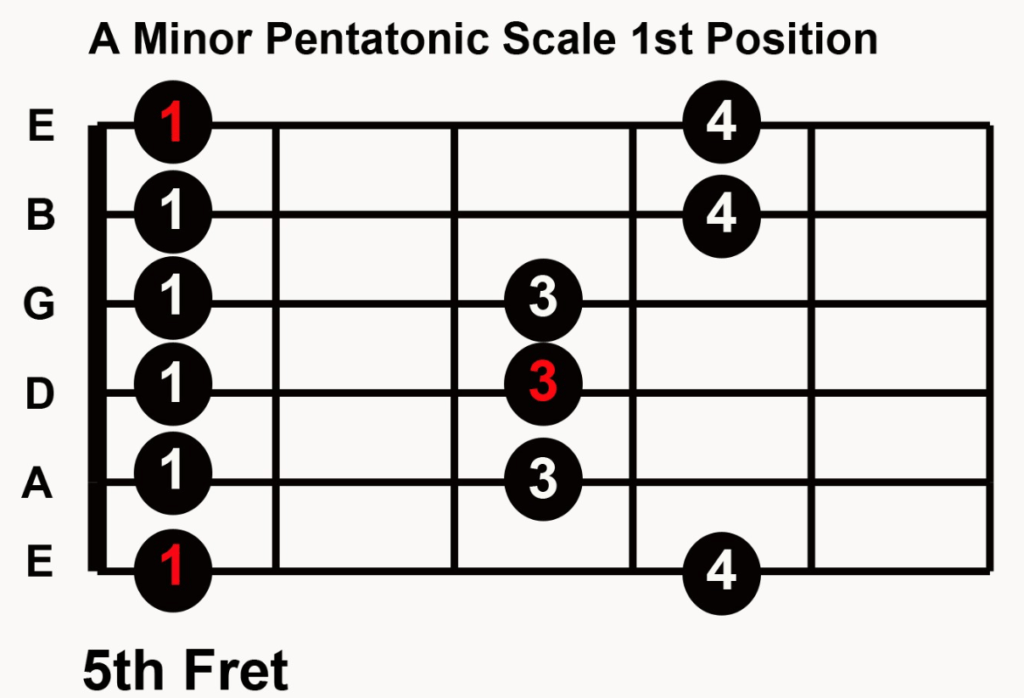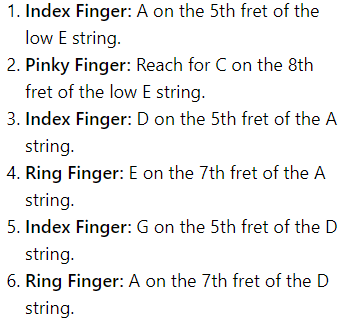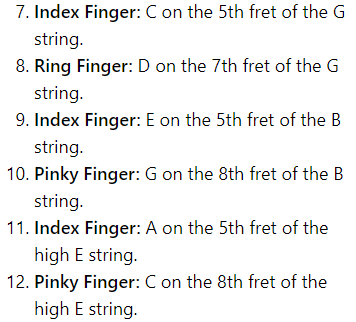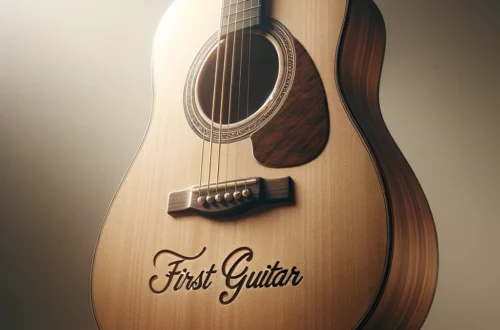
Best Ways To Start Improvising With The A Minor Pentatonic Scale
I’m going to let you in on a little secret, as a beginner the A minor pentatonic scale is your golden ticket into the world of guitar improvisation.
If you’re wondering why this particular scale gets so much attention, it boils down to its popularity and versatility. The scale’s straightforward fingering and position across the fretboard make it an ideal starting point.
The A minor scale is not only easy to pick up but also widely used across countless rock, blues, and pop hits. The beauty of starting with the A minor pentatonic scale lies in its simplicity—only five notes, yet it opens a universe of musical opportunities. We are going to start with one position and one position only, that being the A minor pentatonic, first position.
Imagine being able to jam along with your favourite tunes or even create your own melodies just by mastering these five notes. That’s the power of the A minor pentatonic scale—it transforms beginners into musicians.
Table of Contents
- How Do you Play Basic Pentatonic Scales?
- What is the Easiest Pentatonic Scale to Learn?
- Reasons Why Becoming Great at One Scale Pattern is Beneficial
- How to Learn the Pentatonic Scales
- More Advanced Ways to Make Learning the A Minor Scale Fun
- Easy A minor Backing Tracks for Improvisation
- How to Stay Motivated when Learning Guitar
- Creating Music with the A Minor Pentatonic Scale
- Harnessing the A Minor Pentatonic Scale
How Do you Play Basic Pentatonic Scales?

Image by jucaneryguitar.com
Finger Placement


What is the Easiest Pentatonic Scale to Learn?

Learning the first position of the A minor Pentatonic is probably the easiest scale to learn as a beginner, learning to play the A minor scale up and down will no doubt come incredibly easy for some of us, making it a great place to start.
It’s not just about taking baby steps though, it’s about creating rock-solid confidence in your ability to navigate that initial position, which will set the foundation for all your future guitar playing.
You’re going to find out about how learning one position off by heart opens the door to improvisation more naturally and instinctively.
Once that first position becomes second nature, you can always adjust your approach down the road and explore the rest of the fretboard. But for now, choose something that resonates with you. In the beginning, focusing on the first position of the A minor pentatonic scale is the way for many.
Reasons Why Becoming Great at One Scale Pattern is Beneficial

Experienced Words from my Guitar Tutor
So, I’ve recently jumped headfirst into the exciting world of scales and the topic of scales came up when chatting with my guitar tutor during one of our lessons.
According to my tutor, the key to conquering scales is to master one pattern like a pro and begin utilising it before diving in and trying to take on the whole fretboard at once.
His logic totally clicked with me. He shared this insight from many years of teaching. He said, “Many people can play scales up and down, but not all of them can use scales to start making music in every possible position”. The moral of this story is the whole point of knowing scales is to begin to make music with them.
Now, it’s still an impressive feat to know how to play all the scales up and down, in every position but in reality, it’s more impressive to be able to use those scales to play actual music. Playing scales is cool, but the real magic happens when you can use a scale for improvisation.
Tip
Start with one, get comfortable with it, and let the magic of improvisation unfold. Once you’re grooving with one scale, you can smoothly add more positions and scales into the mix as your understanding of their mechanics becomes crystal clear.
How to Learn the Pentatonic Scales
Before we jump into the exciting world of improvisation with scales, we must understand the notes within the scale. It’s crucial to grasp the fundamentals of what we’re playing. Understanding each note in the scale ensures we can hit the right tones at the right moments, especially when jamming along with backing tracks or other musicians. Let’s break it down.
For the basic A minor Pentatonic scale, here’s the sequence of notes, starting from the high E string:

Memorizing these notes as you navigate up and down the scale will be the stepping stone when it’s time to improvise. With this knowledge firmly in place, you’ll instinctively know which notes to hit and when, making your improvisational journey much smoother.
Perseverance and persistence
I’m going to walk you through some tactics that will get you started, and then later on I will let you in on some of the ways I make my scale practice sessions more fun using the A minor pentatonic scale.
I’m going to be honest, initially, the thought of learning scales came across as a bit boring to me, hence why I have held off on them for so long, this is now an obvious mistake made by myself.
Learning the first position of the A minor scale will more than likely seem tedious at first, but please give it time and follow the steps in this article and I’m sure you will ignite that spark to carry on.
Your time with your instrument should be as effective as it is enjoyable, so let’s focus on techniques that enhance both your skills and your musical experience.
below I have added some basic techniques that you can add to your scale practice to bring some life to playing the scale up and down.
Using a Metronome

Firstly, let’s talk about the importance of a metronome. Starting your practice with its steady beat is not only about keeping time, it’s about developing an internal rhythm that becomes second nature. Start slowly to nail the precision, preferably 60 bpm, then notch up the tempo as you grow more confident. Challenge yourself but don’t rush it—accuracy is king.
One prevalent misstep in the journey of a budding guitarist is sidestepping the invaluable companion – the metronome. Timing and rhythm are the unsung heroes of any great musical performance.
This is not something you have to go out and buy. These can be found on free apps such as Metronome Beats that I use. The other option is to simply type metronome into google and there you are, a ready to use built in metronome on your phone, laptop or desktop.

Use Alternating Picking When Playing Up and Down The Scale
Next up is alternate picking. This isn’t just about alternating downstrokes and upstrokes, it’s also about consistency. Integrated seamlessly into scale practice, alternate picking betters your technique and preps you for any pace. Remember, start slowly and build up speed gradually. This will ensure your pick moves with purpose and alignment with each beat of the metronome.
String Skipping
String skipping was something I struggled with at first when playing up and down the scale. It might sound intimidating, but it’s packed with benefits.
Incorporating this technique with the scale can boost your fretboard navigation and coordination, making your playing stand out. String skipping forces you to think ahead and maintain control, even when you’re skipping over strings and moving across the scale.
Common Mistakes Made By Beginner Acoustic Guitar Players
More Advanced Ways to Make Learning the A Minor Scale Fun

String Bending or Flick Off
Let’s not overlook the power of bending exercises. They’re not about merely hitting those bluesy notes, it’s about control, pitch accuracy, and adding soul to your solos. Begin with a slight bend to get the feel, progressively aiming for a full tone.
Ensure you can hear that note change crisply and at the right pitch before releasing the bend. Experiment with different degrees of bending, from slight to full-step bends, and notice how each affects the feel of your music.
Note!!
This is so much harder to achieve on an acoustic guitar, so if you are using an acoustic, don’t be so hard on yourself. This one may take a while to perfect.
Sliding Notes
Alright, let’s talk about sliding into notes. This is a personal favourite of mine, adding these in really starts to make a scale sound like an actual solo. Adding Sliding notes bridges the gap between notes with an audible glide that’s both smooth and satisfying.
Hammer ons
Let’s talk about a cool technique that can really elevate your playing – the hammer-on. Picture this, you hit a note, and instead of picking the next one, you unleash the power of your fretting hand to smoothly “hammer” onto the fretboard. The result? A clear, distinct sound without a separate pick attack.
This move works wonders, especially when you’re navigating the A minor pentatonic scale, adding a whole new layer of expressiveness to your playing.
String Dynamics
Now, dynamics shouldn’t be overlooked. Playing around with the volume and attack of each note can truly animate your playing. Imagine whispering a secret one moment, and declaring a triumphant message the next. Dynamics can narrate your music’s story without a single word.
Remember, the A minor pentatonic scale isn’t just five notes to practice robotically – it’s a toolkit for self-expression. Try these techniques, but feel free to add your personal touches. Choose something that resonates with you and what you want to say with your instrument. Here’s a short video that hopefully puts some of this into context.
Easy A minor Backing Tracks for Improvisation
Now that you’re familiar with the layout and benefits of honing in on one position of the A minor pentatonic scale, you’re going to find out about employing backing tracks to spice up your practice sessions. One of the best companions you can have while practising scales is a good backing track, especially a blues backing track in A minor.
Why Using A Backing Tracks is Important
A great backing track does more than provide rhythm, it offers context. Through context, you learn how notes interact with one another. You understand why some notes in the scale evoke tension while others resolve it. As you play along, you start to develop a musical intuition—knowing what note to play next as if by instinct.
It’s game-changing and allows the scale to come to life more. Not only that, Since I’ve been using backing tracks, my practice sessions have come to life, making them far more enjoyable.
Backing tracks
Below I have given two examples of backing tracks that I have been using for the A minor Pentatonic scale. The reason I have chosen these particular ones is not only because they sound great, but because they are slow and easy to follow whilst adding in the techniques we discussed earlier.
This is the start of improvisation with the A minor pentatonic scale and will open your eyes to the possibilities moving forward. Give them a try.
I hope you get along with these recommendations as I have, but if not, Choose a track that you prefer, and remember, the aim is to get comfortable. Start with something slow where you can hear the space between the chords.
It’s within these spaces that your notes will dance, and with practice, you’ll find your fingers moving more freely, expressing your unique voice with the A minor pentatonic scale.
In the next section, you’ll learn exactly how to take the scale from a sequence of notes to a source of musical enjoyment.
How to Stay Motivated when Learning Guitar

Having diversity in your practice can transform a routine exercise into an exciting musical journey. Here’s how you can fend off the boredom and make each practice session feel like a new adventure with the A minor pentatonic scale.
First off, let’s talk about short-term goals. It’s easy to feel swamped by all there is to learn, but setting micro-goals turns the mountain into a hike with refreshing checkpoints. Whether it’s getting that one bend just right, or smooth transitions between notes, each little win fuels your motivation.
Here is a snippet of a previous post that I have written that talks all about practice routines and staying motivated to learn the, hard, important and fun stuff.
Daily Guitar Practice Made Easy: Practical Tips For Beginners
Example Practice Routine
10 minutes: Warm-Up
Dive into the A minor Pentatonic scale with a backing track. Not only does this serve as a warm-up, enhancing finger dexterity and coordination, but it also lays the groundwork for improvisation skills down the line. It’s like hitting two birds with one stone by incorporating scales into the warm-up routine.
25 minutes: Licks, Riffs, and Chord Switches
Allocate time to conquer challenging areas, such as the transition from C major to D major. Initially, this switch posed a formidable challenge, so I dedicated time to perfecting it. Additionally, I would mix in a medley of open chords—A, C, D, E, and G—in a random progression to refine my switching speed.
25 minutes: Song Practice
Delve into familiar songs to elevate their quality. When tackling new songs, I invest a dedicated 1 hour every other day to learn them thoroughly. Once acquired, these songs would join my routine as a 10-minute practice interval, where I strive to perfect them alongside a few others.
Variety will help with keeping everything fresh whilst you learn, it’s also the secret sauce for successful practice. Don’t just run scales up and down the neck. Mix in some chord practice, play along with your favourite records, or even write a mini solo. This isn’t just about variety—it’s about context and keeping things stimulating.
Coming up!
In the next section, you’ll learn exactly how to take the scale from a sequence of notes to a source of musical enjoyment.
Creating Music with the A Minor Pentatonic Scale
I’m going to let you in on some insider tips for upping your improvisation game with the A minor pentatonic scale. If you’ve ever wondered how the pros make their solos sound so alive, it often boils down to their approach to phrasing and the feel of their playing.
When you start to apply the scale within songs, you’ll quickly appreciate how it complements various musical styles, especially blues, rock, and jazz. It’s incredibly satisfying to hear how a simple scale can produce such rich, soulful solos and melodies.
To start things off, I have added a perfect Song/exercise video made by one of my favourite YouTube guitarists, Marco Cirillo.
In this specific video, he plays a practice piece that fits perfectly as part of your song practice routine for someone who is learning scales. A piece of music like this has multiple benefits.
- You learn a new song
- it’s short and sweet, so it shouldn’t take forever to get the hang of it.
- He integrates Scales into the fingerstyle playing, (Including the A minor)
- You begin to see how scales are used for improvisation in songs
Remember, the goal is not just to play notes, but to tell a story and connect with your audience through your music, and I feel that Marco Cirillo has done just that. This is such a helpful piece for us beginners.
Harnessing the A Minor Pentatonic Scale
After all the practice and focused effort, there’s the undeniable joy of finally putting it to use in songs. Whether you’re jamming with friends or recording your own tracks, the A minor pentatonic scale is your trusty ally in creating music that resonates.
Remember, improvising isn’t just about technical skill, it’s also about telling a story with your instrument. Each bend, each note you hit, contributes to the narrative you’re weaving.
The A minor pentatonic scale is like an artist’s palette, and your guitar is the brush with which you paint your musical canvas. Now it’s your turn to bring colour and life to the songs you play. Thank you for reading.





